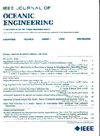The MBARI Low-Altitude Survey System for 1-cm-Scale Seafloor Surveys in the Deep Ocean
IF 5.3
2区 工程技术
Q1 ENGINEERING, CIVIL
引用次数: 0
Abstract
The Monterey Bay Aquarium Research Institute has developed a low-altitude survey system (LASS) to conduct cm-scale seafloor surveys of complex terrain in the deep ocean. The LASS is integrated with a remotely operated vehicle (ROV), which is operated at a 3-m standoff to obtain 5-cm-lateral-resolution bathymetry using a multibeam sonar, 1-cm-resolution bathymetry using a wide-swath lidar laser scanner, and 2-mm/pixel resolution color photography using stereo still cameras illuminated by strobes. Surveys are typically conducted with 3-m line spacing and 0.2-m/s speed and executed autonomously by the ROV. The instrument frame actively rotates to keep the sensors oriented normal to the seafloor. The strobe lights, mounted on swing arms on either side of the ROV, similarly rotate to face the seafloor. Areas of 120 m × 120 m can be covered in about 8 h. Example surveys include 1) deep-sea soft coral and sponge communities from Sur Ridge, offshore Central California; 2) a warm venting site hosting thousands of brooding octopus near Davidson Seamount, also offshore Central California; and 3) a high-temperature hydrothermal vent field on Axial Seamount, on the Juan de Fuca Ridge. An advantage of combining optical and acoustic remote sensing is that the lidar and cameras map soft animals, while the multibeam sonar maps the solid seafloor. The long-term goal is to field these sensors from a hover-capable autonomous platform rather than ROVs, enabling efficient 1-cm-scale seafloor surveys in the deep ocean.MBARI低空测量系统用于深海1厘米尺度海底测量
蒙特利湾水族馆研究所开发了一种低空测量系统(LASS),用于对深海复杂地形进行厘米尺度的海底测量。LASS集成了一个远程操作潜水器(ROV),可以在3米的距离上操作,使用多波束声纳获得5厘米的横向分辨率测深,使用宽波段激光雷达激光扫描仪获得1厘米分辨率的测深,使用闪光灯照明的立体静止相机获得2毫米/像素分辨率的彩色摄影。测量通常以3米的线距和0.2米/秒的速度进行,并由ROV自主执行。仪器框架主动旋转,以保持传感器的方向与海底垂直。安装在ROV两侧的摇臂上的频闪灯也会朝着海底旋转。120米× 120米的区域可以在大约8小时内覆盖。示例调查包括:1)加利福尼亚中部近海苏尔里奇的深海软珊瑚和海绵群落;2)在戴维森海山附近的一个温暖的排气点,那里有成千上万只孵化章鱼;3)胡安德富卡脊轴向海山高温热液喷口场。光学和声学遥感相结合的一个优点是激光雷达和照相机绘制软体动物的地图,而多波束声纳绘制固体海底的地图。长期目标是将这些传感器部署在悬停式自主平台上,而不是rov上,从而在深海中进行有效的1厘米尺度海底调查。
本文章由计算机程序翻译,如有差异,请以英文原文为准。
求助全文
约1分钟内获得全文
求助全文
来源期刊

IEEE Journal of Oceanic Engineering
工程技术-工程:大洋
CiteScore
9.60
自引率
12.20%
发文量
86
审稿时长
12 months
期刊介绍:
The IEEE Journal of Oceanic Engineering (ISSN 0364-9059) is the online-only quarterly publication of the IEEE Oceanic Engineering Society (IEEE OES). The scope of the Journal is the field of interest of the IEEE OES, which encompasses all aspects of science, engineering, and technology that address research, development, and operations pertaining to all bodies of water. This includes the creation of new capabilities and technologies from concept design through prototypes, testing, and operational systems to sense, explore, understand, develop, use, and responsibly manage natural resources.
 求助内容:
求助内容: 应助结果提醒方式:
应助结果提醒方式:


